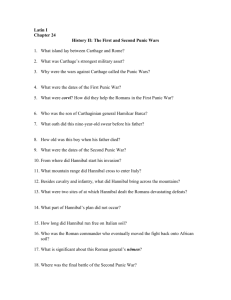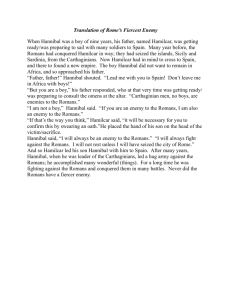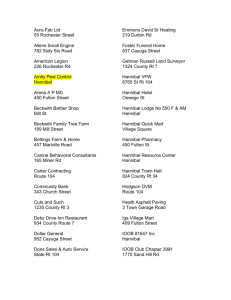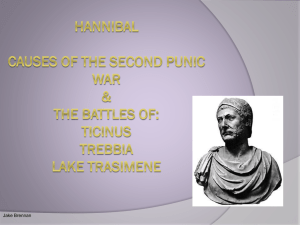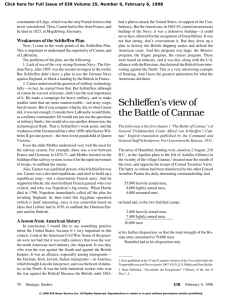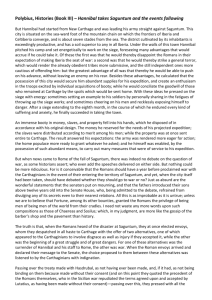OCR Nationals - John D Clare
advertisement
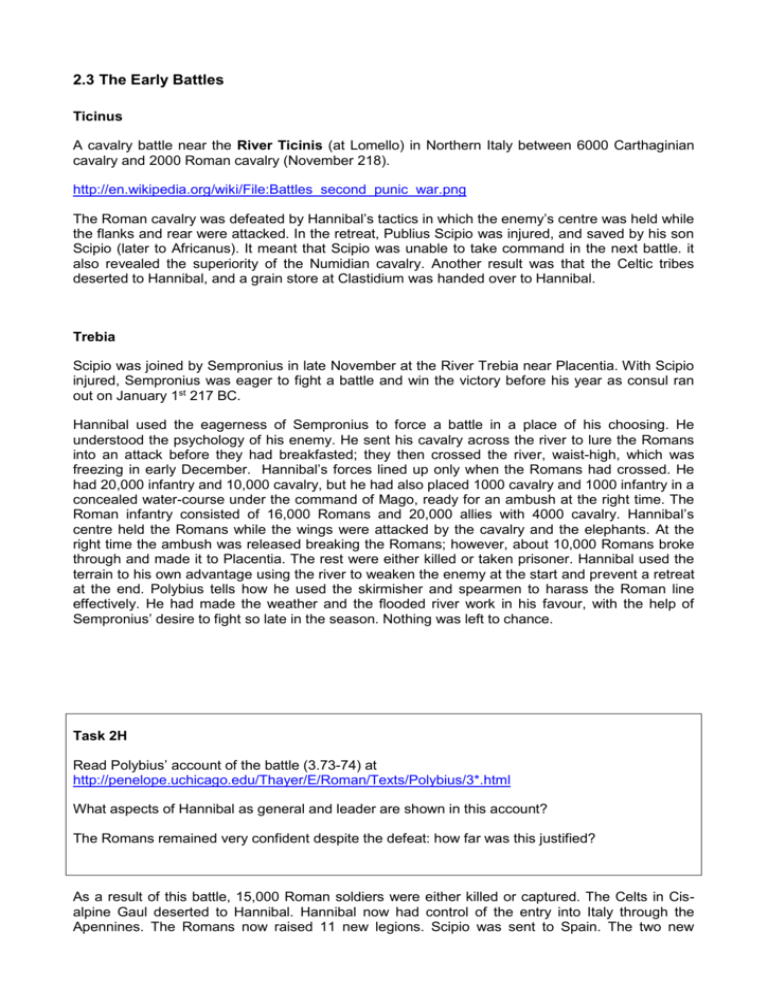
2.3 The Early Battles Ticinus A cavalry battle near the River Ticinis (at Lomello) in Northern Italy between 6000 Carthaginian cavalry and 2000 Roman cavalry (November 218). http://en.wikipedia.org/wiki/File:Battles_second_punic_war.png The Roman cavalry was defeated by Hannibal’s tactics in which the enemy’s centre was held while the flanks and rear were attacked. In the retreat, Publius Scipio was injured, and saved by his son Scipio (later to Africanus). It meant that Scipio was unable to take command in the next battle. it also revealed the superiority of the Numidian cavalry. Another result was that the Celtic tribes deserted to Hannibal, and a grain store at Clastidium was handed over to Hannibal. Trebia Scipio was joined by Sempronius in late November at the River Trebia near Placentia. With Scipio injured, Sempronius was eager to fight a battle and win the victory before his year as consul ran out on January 1st 217 BC. Hannibal used the eagerness of Sempronius to force a battle in a place of his choosing. He understood the psychology of his enemy. He sent his cavalry across the river to lure the Romans into an attack before they had breakfasted; they then crossed the river, waist-high, which was freezing in early December. Hannibal’s forces lined up only when the Romans had crossed. He had 20,000 infantry and 10,000 cavalry, but he had also placed 1000 cavalry and 1000 infantry in a concealed water-course under the command of Mago, ready for an ambush at the right time. The Roman infantry consisted of 16,000 Romans and 20,000 allies with 4000 cavalry. Hannibal’s centre held the Romans while the wings were attacked by the cavalry and the elephants. At the right time the ambush was released breaking the Romans; however, about 10,000 Romans broke through and made it to Placentia. The rest were either killed or taken prisoner. Hannibal used the terrain to his own advantage using the river to weaken the enemy at the start and prevent a retreat at the end. Polybius tells how he used the skirmisher and spearmen to harass the Roman line effectively. He had made the weather and the flooded river work in his favour, with the help of Sempronius’ desire to fight so late in the season. Nothing was left to chance. Task 2H Read Polybius’ account of the battle (3.73-74) at http://penelope.uchicago.edu/Thayer/E/Roman/Texts/Polybius/3*.html What aspects of Hannibal as general and leader are shown in this account? The Romans remained very confident despite the defeat: how far was this justified? As a result of this battle, 15,000 Roman soldiers were either killed or captured. The Celts in Cisalpine Gaul deserted to Hannibal. Hannibal now had control of the entry into Italy through the Apennines. The Romans now raised 11 new legions. Scipio was sent to Spain. The two new consuls, C. Flaminius and Servilius Geminus were to confront Hannibal when he crossed the Apennines. 2.4 Battle of Lake Trasimene Hannibal’s route into Etruria: He appears to have taken the road over the Collina Pass into the marshy area of the River Arno which was flooded at this time of the year. Most of the baggage animals were lost in the marshes and the horses developed scurvy. Hannibal had ophthalmia and lost the sight in one eye. The exact site of the battle is uncertain. Flaminius certainly did not fall into every trap that Hannibal set; despite the devastation he remained in camp at Arretium. Even when Hannibal marched round the left flank of Flaminius, the consul did not move. Only when he moved off towards Cortone and Apulia did Flaminius follow. He may have been waiting for his fellow consul to arrive; he knew he could not let Rome’s allies lose crops and possession in Hannibal’s destruction of the land. Flaminius had a history of success, particularly against the Insubres and would have been seen as a sound choice. However, in the sources, he seems to behave without much sense and understanding. Task 2I Read the following passages: Hannibal decided that for many reasons Flaminius was bound to give him ample opportunity to attack. In this his calculations were both sound and thoroughly realistic. No-one in his right mind could reasonably argue that there is anything more important to the art of military command than an understanding of the character and temperament of the enemy general. Polybius 3. 81.1 On this occasion Hannibal had certainly anticipated the plans of Flaminius, the Roman commander, and got the measure of his opponent. As a result his plan proved totally successful. As soon as he had struck camp and moved off from the area of Faesulae, he advanced a short distance beyond the Roman camp and launched a raid upon the surrounding countryside. Flaminius was immediately beside himself with rage, convinced that this was a deliberate insult by his opponents. Polybius 3. 81.12 -82.2 As he marched he continued to devastate the countryside with fire and sword, with the deliberate intention of provoking his opponents to battle. He now saw that Flaminius was already getting close. As he had identified a position ideally suited to his plans, he made ready for battle. Polybius 3. 82.10-11 What do we learn of about Polybius’ opinion of Hannibal and Flaminius from these passages? Is Polybius being fair to Flaminius in 3.81-82? Read Polybius 3.81-82: list the differences between Hannibal and Flaminius as leaders. Hannibal moved along the north shore of Lake Trasimene setting an ambush: read the following passage and draw a plan of the placing of the troops. Hannibal marched along the side of the lake and through pass, and then personally led the occupation of the hill in front, on which he set up camp with his Spanish and Libyan soldiers. He then sent his Balearic slingers and spearmen round to front and stationed them to his right on the lower slopes of the hills that lay along the line of pass. Meanwhile in a similar manoeuvre he led his cavalry and the Celts round the hills to his left, and stationed them in extended line so that their extreme left flank lay at the entrance to the pass itself (as already described) between the lake and the hillsides. Polybius 83.2-4 The following websites have plans and photographs of the battle field so you can check how accurate your plan is: http://en.wikipedia.org/wiki/File:Battle_of_lake_trasimene.gif http://www.livius.org/to-ts/trasimene/trasimene.html Flaminius followed Hannibal into the pass very early the next day. In the mist, unable to see the enemy forces, Flaminius and his army were completely surprised when attack on all sides. 6000 men in the front fought their way through but were rounded up later. Two legions were destroyed. A second success followed when Maharbal and the cavalry destroyed 4000 Roman cavalry sent by Servilius near Assisi. (Polybius 3.86.3) However, no towns in Eturia and Umbria opened their doors to Hannibal despite his actions after the battle: When he had finished, he handed over the Roman prisoners to his various regiments to be kept under guard, but released the allied troops without ransom and sent them all home. 85.4. declaring, as he had on previous occasions, that he had not come to make war on the Italians but to fight for their freedom against the Romans. Polybius 3.85.3 Task 2J Polybius 3. 83-4 gives a detailed account of the battle: what does he say about (a) Flaminius’ role in the battle? (b) the behaviour of the Roman soldiers? (c) the tactics used by both sides? The importance of the battle of Lake Trasimene: Hannibal had control of central Italy and its resources but had not secured the support of the cities of the Confederacy. His losses amounted to 1500 - mostly Celts [Livy says 2500]. There was no army between Hannibal and Rome. Rome had one consul instead of two and no effective army in the field. Roman strategy changed from the offensive to defensive: Quintus Fabius Maximus Verrucosus was appointed Dictator. with the policy of avoiding battles, keeping to the hills, depleting Hannibal’s forces by frequent attacks and giving his own soldiers renewed confidence Two new legions were raised which joined Servilius force Polybius tells us what happened after the battle: At the same time he sent messengers to report back to Carthage on the turn of events, despatching them by sea, because this was the first time he had reached a coastline since invading Italy. The Carthaginians were delighted by the news, and with great enthusiasm set about organising support for their armies in Italy and in the Iberian peninsula. The Romans meanwhile appointed Quintus Fabius as Dictator. He was a man of admirable character and supreme intelligence, and his descendants to this day bear the surname Maximus, “the Greatest,” in recognition of his victorious achievements. … At the same time Marcus Minucius was appointed Master of Horse. This officer is subordinate to the dictator, but acts as his deputy, taking command when he is elsewhere. Polybius 3.87.4-6 2.5 Quintus Fabius Maximus Verrucosus The Romans meanwhile appointed Quintus Fabius as Dictator. He was a man of admirable character and supreme intelligence, and his descendants to this day bear the surname Maximus, “the Greatest,” in recognition of his victorious achievements. Polybius 3.87.6 http://ancienthistory.about.com/od/romansag/g/FabiusMaximus.htm on the background to Quintus Fabius [with a link to Plutarch’s Life of Fabius]. Fabius took over Servilius’ army and marched to Apulia and camped at Aecae near the enemy. Hannibal moved in Campania while Fabius followed. His strategy allowed Hannibal to destroy allied land, causing economic loss and a lowering of morale. Fabius at one point thought he had Hannibal trapped as he tried to move back north. But Hannibal tricked Fabius when he drove 2000 oxen with burning sticks attached to their horns towards Fabius’ camp at night. In the confusion Hannibal’s army slipped past Fabius. (Livy 22.15-17) Task 2K Read Polybius’s assessment of the situation and his contrast between the Romans and the Carthaginians at this point in the war (3.89). What difficulties did Fabius face both against Hannibal and with his own people? Plutarch gives us the following account: He concentrated all his own thoughts on Hannibal. He had no plans for a single fight to the finish, since his enemy was at the peak of his strength. So his strategy was to wear him down over time, to use Rome’s financial strength to counter his limited resources, and Italy’s manpower to decrease his relatively small army. Plutarch, Life of Fabius Maximus, 5.1 The civilian population viewed such time-wasting tactics with contempt. He certainly had a poor reputation in his own army, but the Carthaginians went further, despising him as an insignificant coward. Only one man saw it differently – and that was Hannibal himself. He alone understood his opponent’s strategy and realised how intelligently he applied it. He realised that he must use every possible tactical device to bring him to battle. Otherwise the Carthaginians would be done for, unable to use the weaponry in which they were superior, while steadily losing their already inferior manpower and wasting their inadequate resources with nothing to show for it. Plutarch, Life of Fabius Maximus, 5.2-3 His Master of the Horse, Minucius, wanted a much more aggressive strategy and tried to undermine his command among the soldiers. When urged by his friends to counter the insults of Minucius he replied (according to Plutarch 5.6). “If I did that, I would be an even greater coward than I now appear, since I would be abandoning my calculated strategy for fear of a few jokes and insults. There is no disgrace in being afraid for the future of one’s country; but if a man is frightened of the insults and criticisms of popular opinion, he betrays his high office and becomes a slave to the fools over whom it is his duty as ruler to exercise control.” Task 2L How is Fabius characterised by Plutarch? Livy tells us how Fabius was partly undermined by a cavalry action by Minucius which had some success but which was exaggerated by Minucius when reporting to Rome. He had forced Hannibal to move his camp. When Fabius returned to the camp from Rome after power was to be shred between him and Minucius, they decided to divide the army rather than sharing the command. Minucius fell into a trap set by Hannibal on hilly, broken ground suited to his ambushes and Minucius’ forces were saved only by the arrival of Fabius’ army (Polybius 3. 104-105). However, Fabius’ term of office ended in 217 BC and new consuls were elected for 216 BC: Terrentius Varro and Aemilius Paulus. Livy’s account of the treatment of Fabius This describes the treatment of Fabius by the Roman people and the Senate and displays a sympathy for Fabius and portrays him as an honourable patriot who refuses to be diverted from what he knows is right. Minucius is the popular leader, not a member of the traditional aristocracy. Everyone in Rome and in the army, whether friend or foe to Fabius, regarded this decision as a calculated insult – except the Dictator himself. With the same calmness and mental resolution as he had endured the denunciations of his enemies in the popular assemblies, he now bore this cruel injustice inflicted on him by an angry nation. En route for the army, he received the despatches reporting the Senate’s decree (senatus consultum) about the division of powers. But undaunted and undefeated by citizen or enemy alike, he rejoined the army, entirely confident that no legislation could enforce equality of military genius along with equality of military command. Livy 22.26.5-7 Compare this with Livy’s portrayal of Varro at 22.26: As a young man, Varro had inherited the fruits of his father’s “business” activities, and immediately conceived somewhat loftier ambitions. Smart suits and political activity (literally: the toga and the forum) became his stock in trade and he began to make speeches on behalf of the dregs of society. By taking up such populist causes and denouncing the wealth and reputation of the better class of citizens, he soon won himself a national reputation amongst the common people, and thus gained political office. He became a treasury official (Quaestor), and was then twice elected a city magistrate (Aedile), first as a deputy to the Tribunes (Plebeian Aedile), and then as a part of the city administration (Curule Aedile). Finally, having won the praetorship and completed his term of office, he had now set his eyes on the consulship. He had sufficient low cunning to make political capital out of the Dictator’s unpopularity, and when the proposal (to divide the powers of the dictatorship) was carried in the popular assembly (became a plebiscite), he alone got the credit. Livy 22.26 Varro was a ‘novus homo’ – a new man whose family had never held the consulship: but he must have had support in the Senate to succeed in politics and cannot have been the enemy of the Senate as the sources suggest. Aemilius was the patrician aristocrat who is presented as cautious and sensible, who had already held a consulship in 219 BC. He was the experienced statesman, Varro the young and inexperienced hothead. The ancient accounts always present events as the result of the characters of those involved, and the accounts of 216 BC are no different. 2.6 The Battle of Cannae The Romans increased their army to eight legions (according to Polybius), although it is thought that 80,000 Roman soldiers and allies is far too large an army. Hannibal’s force amounted to 40,000 infantry and 10,000 cavalry (Livy 22.46.6). The Roman army was probably slightly larger in infantry but less in cavalry. Hannibal had taken the supply-depot at Cannae on the right bank of the River Aufidus. He had chosen a site suitable for his cavalry. Livy explains how the commanders differed on their approach, just as Fabius and Minucius had. Once again disorder broke out in the Roman camp, with the troops proving mutinous and the consuls incapable of agreement. Lucius Aemilius Paulus (Varro’s colleague in the consulship) kept reminding Varro of what had been the results of the rash leadership of Sempronius and Flaminius; Varro sarcastically threw back at him Fabius’ “wonderful” example, as a cowardly and un-enterprising general. Livy 22.44.5 Once the forces were massed at Cannae, the commanders shared the command on alternate days. Livy (22.44.5) gives the impression that Varro crossed the river and drew up the battle line without Aemilius’ agreement on a day when he had command. The Infantry was massed in the centre, with cavalry on the wings, each consul taking command of a wing (22.45.6-8). Livy (22. 46) describes the Carthaginian formations, although he does not mention that the infantry were drawn up in a crescent shape at this point. However, at 47.7 he makes it clear that this was the tactic. Hannibal had aimed to contain the attack of Roman infantry and then use it against them in a trap. Polybius describes the formation as a ‘moon shape’. It was meant to take the shock of the attack from the Romans. The Celts and Spaniards in the centre did not break- if they had done so and the Romans had broken through their superiority in infantry the Romans would have won the battle. The Africans on the wings turned inwards and attacked the sides of the Romans. Then the heavy cavalry of Hasdrubal attacked the rear of the Roman lines. Aemilius Paulus, Servilius, Minucius, 80 senators, 29 military tribunes, 45,500 infantry and 2,700 cavalry (Livy 22. 49). Polybius (3.117) says 70,000 Romans died and about 10,000 were captured. Varro escaped to Venusia with about 50 cavalry. Scipio Africanus with some infantry reached Canusium. Carthaginian losses were 4000 to 5,700 Celts, 1,500 Spaniards and Africans and 200 cavalry (Polybius 3.117). Task 2M Research the full account of the battle: http://www.roman-empire.net/army/cannae.html http://www.fordham.edu/halsall/ancient/polybius-cannae.html http://www.livius.org/ha-hd/hannibal/hannibal.html Did Hannibal win because of his own military skill or because of Roman incompetence? Maps of Cannae http://www.livius.org/a/1/maps/cannae_map.gif After the battle Task 2N Why did Hannibal not immediately march on Rome? Do you think it was the right decision? Read the following extracts and information and make points for and against his decision. In his moment of victory Hannibal was surrounded by his staff, crowding round to congratulate him and urge him after such a massive success to spend the remainder of the day and the following night resting himself, and giving his exhausted soldiers time to recover. But Maharbal, his cavalry commander would have none of it, urging him not to waste a moment. “I’ll tell you what this battle has really achieved,” he declared, “when in five days time you are feasting on the Capitol. Follow up quickly. I’ll go ahead with the cavalry, and before they even realise we are coming, the Romans will discover we’ve arrived.” For Hannibal it all seemed far too optimistic, an almost inconceivable possibility. He commended Maharbal for his imaginative idea, but said he needed time to think it through. Maharbal’s reply was short and to the point. “The gods do not give all their gifts to any one man. You can win a battle, Hannibal. But you have no idea how to exploit it.” That single day’s delay, by common consent, proved the salvation of Rome and her empire. Livy 22.51 So, why didn’t he march on Rome immediately? Many towns in Apulia, Samnium, Lucanai and Bruttium revolted to Hannibal; Capua followed in the autumn giving him a good base for the winter. it looked as though the confederacy was breaking up. However Etruria, Umbria and Latium remained loyal to Rome, as did most of the coastal cities of Campania. Rome’s army in Italy was destroyed and her finances were seriously lessened with demands from Sicily and Sardinia for pay for army and fleet. However, Hannibal did not have the equipment to undertake a siege, nor the numbers to starve Rome to surrender. His veterans were reduced in numbers since 219 BC and he needed fresh reserves which were not immediately sent. He received 4000 cavalry and 40 elephants. Instead Hannibal consolidated his support in the south and used his forces to garrison towns, thus dividing and weakening his army. Supplies would be a constant worry. Protecting his new allies became his concern and as such he lost the initiative.
